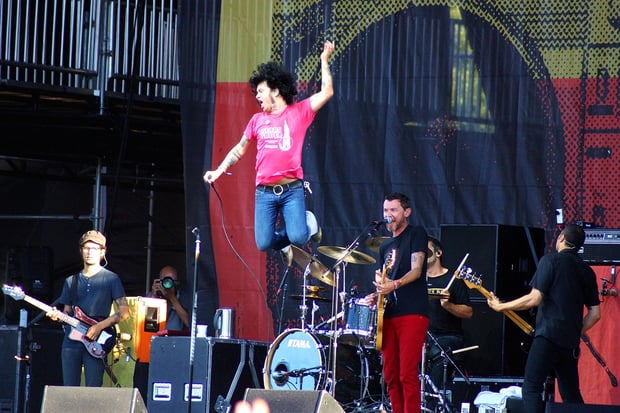 Photo by Shane Hirschman via Flickr / CC BY-SA 2.0
Photo by Shane Hirschman via Flickr / CC BY-SA 2.0
The best live records not only showcase the sound of the band, they usher the listener into a realm of passion and spontaneity, a place where anything could happen. That’s if the sound quality doesn’t flat-out suck and if the bass is present in the mix and the singing is more or less in key. What happens up there may not be predictable, but there are proven ways to manage the chaos and create a great recording of your live show.
1. Use multiple sound sources
The best live recordings don’t just come from the board. They don’t just come from two condensers attached to a recorder in back of the room. They’ll be a mix of all these things, just like a good live video is a mix of several cameras. If you have access to any sort of DAW to blend these sources, get your hands on all the sources you can: a recorder in the crowd to capture their reaction, a hot mix straight off the board, and some sort of high-quality room recording.
Amazing fidelity isn't the goal here – it’s to capture the feel of the concert while making sure every instrument and voice is heard. Blending sources will also allow you to find lost voices in the mix. High stage volume instruments like drums sets tend to be downplayed in board mixes but loud in the audience. You can find a happy medium in which everything's audible.
2. Diverge from your studio recordings
Nobody wants to hear note-for-note renditions of your studio stuff. A live show should expand on what you do, giving you the space to improvise, to extend anthemic bits, and to perform covers and B-sides that you might not put on an official recording. It’s also the place for give-and-take with the audience, funny stories from your lead singer, and any other off-the-cuff changes you feel like making to your own music.
This means you have to be tightly rehearsed and have great communication. If playing your own material is easy, it’ll be easy to change on the fly and take your audience for an exciting ride. Crowds love things like unaccompanied solos by a guitarist or singer, extended intros while a vocalist talks about what inspired the song, and false endings. Also, this is where we learn how all those songs that were faded out on the record actually end.
[Why (and How) to Shape Your Performance Like an Action Film]
3. Keep your singer sober
Alcohol can make your whole body loosey-goosey, but in particular, it targets the vocal cords. Singers pay the price for drinking onstage, losing control of pitch and timbre but imagining that it sounds fantastic. No matter how much fun the show was in the moment, a drunk singer will be immediately (and painfully) obvious on a live recording. So save your Dewar's on the rocks for after the show.
4. Play two takes, just like the studio
If at all possible, make your live recording during a longer set… preferably two sets. If you can play at least some of the same numbers twice during the gig, you’ll have options to choose from while still maintaining the same sound. Then you can argue with your drummer, who agrees that the second take was better, but played a totally sick fill during take one.
5. Find great room sound
Honest studiophiles everywhere have learned to stop trying to record in dead rooms and try to add ambiance later. A great room sound makes a great recorded sound – all you have to do is capture it.
Medium-sized clubs generally sound better than ice arenas. Rooms with lots of glass sound worse than rooms with lots of carpet and wood. And indoor shows sound better than outdoor ones. If you can perform in a decent room, the sound of your live recording will improve drastically and you won’t have to tweak it to death to render it listenable.
6. Cross-fade your audience noise in between tracks
If you’re creating a full-length live recording, there’s no need for silence between tracks. You want your listeners to feel as though they’re there at the show, right? Don’t mess with the illusion and remind them that they’re actually driving their dog to a grooming appointment, or sitting in the living room folding laundry.
Fade one track into another, covering the splice with applause. Just overlap the applause and screaming between each song and crossfade the two tracks using a digital audio workstation.
7. Add some behind-the-scenes banter to expand the experience
You’ve got microphones, so use them. Record your soundcheck. Record your jokes and conversation backstage. Let your audience into your world a little bit, showing them what it’s like to be in your band, driving to the gig, loading in, and getting coffee at some truck stop afterwards. Example: When Linkin Park's Mike Shinoda ordered his Frappuccino.
These details make an enhanced live record, which is a must when trying to turn a full sensory experience into something that’s just a feast for the ears.
Next up: 6 Tips to Get the Best Live Recording of Your Festival Set
Jesse Sterling Harrison is an author, recording artist, and part-time farmer. He lives in Massachusetts with his wife, three daughters, and a herd of ducks.







